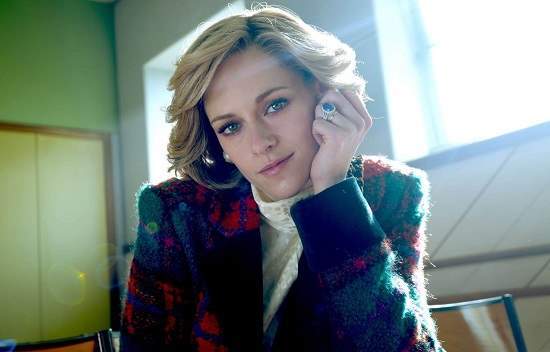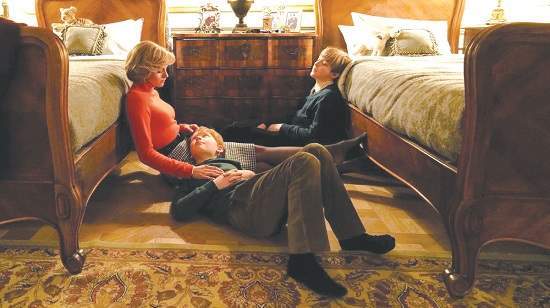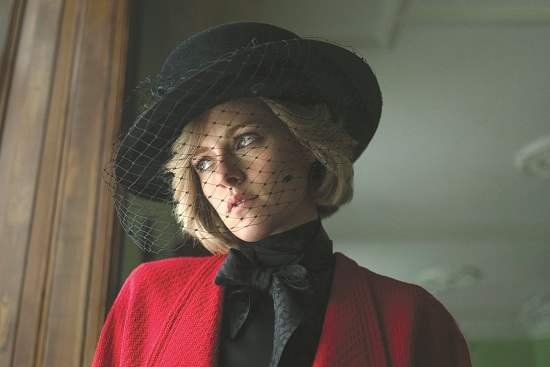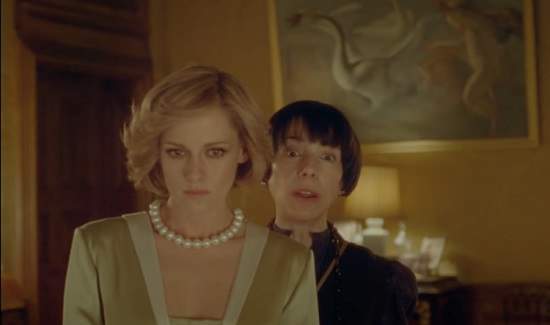“
Spencer” by Pablo Larrain premiered at the 78th edition of the
Venice Film Festival on September 5 and was released to cinemas worldwide on November 5. The movie presents an agonizing dive into the tortured soul of Princess Diana. Sublime and heartbreaking, the movie is one of Kristen Stewart’s best roles.
اضافة اعلان
Set in December of 1991, Princess of Wales traveled to Sandringham House to join the Royal Family for their Christmas celebrations. Amidst the sinister atmosphere, a few months before her divorce from Prince Charles, the movie follows Princess Diana Spencer as she tries to find her balance.
The scope of Diana’s painful introspection is admirably modulated, both narratively and in the acting of Kristen Stewart, who disappears under the guise of the “People’s Princess.”
“Spencer” returns to a critical period in the life of Princess Diana. This biographical movie is presented as a tale built around facts, a genre that allows freedom from history. But, above all, this allows the filmmaker to create a narrative and formal approach that frees the movie from its historical shackles.
This chosen genre is no coincidence, as Princess Diana struggled during her lifetime to free herself from the royal expectations.
 (Photos: IMDb)
(Photos: IMDb)
The prologue of the movie is performed with subtle mastery. At daybreak, a military convoy can be seen in the distance carrying the royal victuals in the English countryside. The movie takes place in a large mansion, where Diana is practically captive. Even outside the atmosphere changes, the light at the film’s beginning dims to gray and dull before taking on an almost nightmarish form.
Larrain is skilled at translating the complex and sometimes-contradictory emotions that plague Princess Diana. Throughout the movie, the heroine’s mental health deteriorates as her morbid thoughts haunt her, even in her sleep before they manifest themselves in hallucinations.
Mental struggle
As much as Princess Diana would like to reject the royals who oppress her, she suffers from feeling judged at every turn. Her essence of control, her bulimia, is approached without evasiveness. The movie covers the alienation that grows and culminates in the princess during these three pivotal days.
The knowledge of her tragic fate makes several scenes poignant. For example, the scene where she chats with her dresser and confidante, played by Sally Hawkins, notes that once time has done its work, the monarchs will be summed up in just one word, such as William the Conqueror or Elizabeth the Virgin Queen.
 (Photos: IMDb)
(Photos: IMDb)
These words plague Princess Diana’s mind as she thinks of what qualifier will be attributed to her by history. However, the reflection of these markers is far from vain; on the contrary, Princess Diana presents melancholy, vulnerability as she tries to float above the rigid expectation set for her by the royal family, history, and herself.
Small details
Visually exquisite, the film is filled with studied touches across the board, including the book Diana finds on her nightstand by Anne Boleyn, “The Princess and Martyr.”
This book allows the princess to draw parallels between herself and the second wife of Henry VIII: “She was accused of having a lover when it was he who had a mistress,” notes Diana after hearing of Camilla Bowles.
The princess nicknamed Bowels, Jane Seymour, in reference to the woman who took Anne Boleyn’s place after she was guillotined, showing the complex emotions Diana felt.
 (Photos: IMDb)
(Photos: IMDb)
In the scene where the kitchen staff is entering the dining room simultaneously as her presents briefly, a cloud in which Diana seems to be drowning in, presenting her disconnection from everything in the mansion, even those who are not closely related to her.
The constant surveillance Diana is subjected to is highlighted when she thinks the only escape is running away. However, the surveillance reaches a tipping point when Diana hears a knock on the closet door where she took refuge to escape the constant monitoring.
The true haunting detail of her hiding ordeal is her two sons, whom she coaxes into her hiding space and tries to protect. During the scene where they are having fun in the middle of the night, in total secrecy, the dialogue and the emotion are so natural, so genuine, that one would think the moment was improvised.
New era for Larraín
With “Spencer,” Larraín continued what seems to be the second phase of his work. After a majority of films carried out by unusual male characters, his switch to movies covering extraordinary women, such as Jackie and Ema, is noted,
However, paradoxically, his structure of this movie is all in one simple location, presenting an eventful stay at Sandringham Estate through three acts, unlike his previous works.
The filmmaker evokes the protagonist’s isolation by filming close-ups with a wide-angle lens which accentuates her perspective and exacerbates the separation between Diana and her environment.
 (Photos: IMDb)
(Photos: IMDb)
Larraín does not claim to deliver the ultimate and definitive truth about who Princess Diana was. However, unlike many biographical productions, his approach is more about trying to understand who she was than explaining who she was. This nuanced difference is fundamental to the movie.
Based on a detailed and erudite script by Steven Knight, the filmmaker looked at Diana with real empathy. A quality that allows viewers to watch this story and gain insight to the princess’ struggle and understand her humanity.
Read more Trending news



